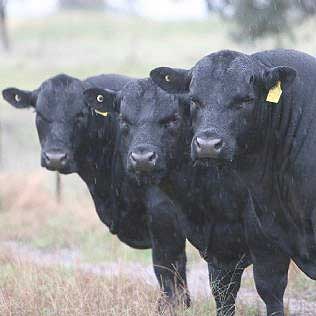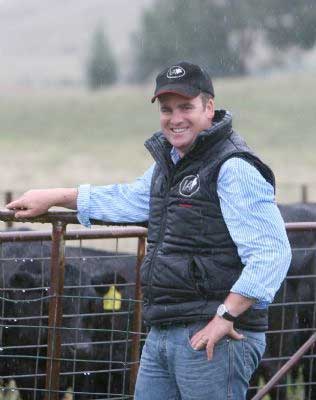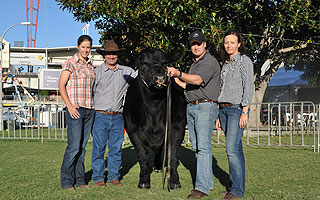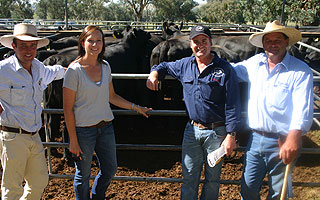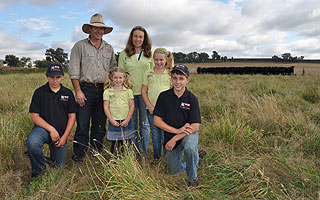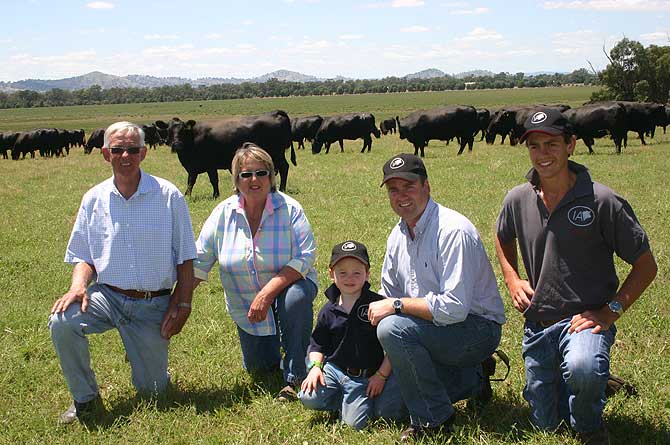Ireland’s Angus – A Passion for Angus
Weekly Times | Kim Wood | March 4, 2011
Focused: Corey Ireland has one of the largest registered Angus herds in Australia.
Prime beef: Young Angus bulls on-farm at Ireland’s Angus at Wagga Wagga, NSW.
THERE are few stud producers under the age of 40 who can claim to have 26 years of cattle breeding under their belt. However Corey Ireland is one of them.
Since the age of 10, he has been singularly focused on breeding a quality herd of stud Angus cows.
Today at 36, he has assembled one of the largest registered Angus herds in the nation with 650 females.
Last year was one of highs and lows for Corey and his wife, Prue.
While their Wagga Wagga, NSW farm was isolated four times by major floods, they had a clean sweep at the Royal Melbourne Show and negotiated the purchase of the entire Geramy Angus stud.
The Geramy purchase from Peter and Margaret Slatter, of Holbrook, involved 260 autumn-calving registered cows, and 100 mixed-sex weaners. The cattle were shifted to their new Riverina home in a dozen B-doubles over two days.
Ireland’s Angus now has an array of bull-producing females, giving Corey and Prue the ability to supply large numbers of bulls into western NSW and Queensland. They are seeking co-operator Angus herds to progeny-test their young stud sires.
But the bottom line for any stud, according to the Irelands, is the performance of the steer progeny in the feedlot or on the kill floor. Last year 2000 Ireland-blood steers were sold by the stud’s clients. The 2009-drop steers, with an average weight of 451kg, returned 207c/kg or an average price of $932.
The stud ranks highly for marbling on Breedplan at 4.65 per cent, compared with the breed average of 3 per cent.
“Breedplan is a tool we use for selection – we like a balance of traits and the cattle have to be structurally correct and sound,” Corey said.
He has always been a stickler for breeding sound, functional, high-performing cattle suited to the environment.
At 10 years old, Corey went against the family grain of breeding Herefords and started Ireland’s Angus in 1984, with a handful of heifers with his brother, Michael. Their newly founded stud was run on the family farm at Warragul.
Wal Kenney, of Kyloh Angus at Darnum, took the young Corey under his wing and mentored him on all things cattle-related.
“Wal Kenney gave me a really good foundation – we focused on breeding for reasonable frame, weight and soundness,” Corey said.
Corey studied agribusiness at Marcus Oldham College before joining the finance arm of Landmark.
Prue, who worked as the marketing manager for Essendon Football Club, also grew up with cattle. Her family ran the Pickett Range and Onkaparinga Simmental studs in South Australia.
Living and working in Melbourne, the couple always had an ambition to run a specialised stud operation on their own farm.
“We were agisting our cattle at Albury and most of our bull clients were in the Riverina,” Corey said.
“We started looking at properties in 2003 when the market was red hot – unless you signed the papers on the day, you missed out.”
“Our first aim was to buy a business that was drought-proof and near a major centre.”
They invested in a bookstore at Wagga Wagga, which is now run by Prue and 20 staff.
In February 2004, the couple took over the 250ha property Ivydell in the Kyeamba valley, east of Wagga Wagga.
“This farm had a secure rainfall and was close to a major centre – it fitted the bill,” Corey said.
Accompanied by their stud herd of 40 autumn and spring calving cows, the couple hit the ground running in severe drought.
“Perfection being the nature of the beast, I started with getting the soils right and pastures improved,” Corey said.
Lime applications of 3 tonnes/ha lifted soil pH to 5-5.2 for the establishment of phalaris-based pastures and lucerne.
“I wanted to get a feel for the place before I began re-fencing it,” Corey said.
“We spent two years with limited cattle yards – we slowly pieced together a plan.”
Ivydell has since been refenced according to land capability, deciduous and native trees planted, dams cleaned out and a system of troughs installed.
A new set of cattle yards complements holding paddocks, a sales ring and amphitheatre.
This was all achieved while Corey worked full-time in finance with Landmark Wagga Wagga. He has since established a joint-venture mortgage broking company with Ruralco and continues to work full time.
Corey has no interest in running commercial cattle.
“I have focused my skills on a specialised seedstock operation – that is the thing I love,” he said.
“Having my clients profiting from using our genetics is where I get my kick from.”
He culled any cows with poor constitution during the drought.
“Our bigger-framed cows are not extreme but have constitution and capacity,” he said.
“We have had to make every cow work as a matter of risk reduction.”
The majority of heifers are joined naturally to calve at two years, using home-bred bulls in a progeny test program.
Over the years genetics from the US, Canada and New Zealand have been used selectively in embryo transfer and artificial-insemination programs.
The stud sells 100 bulls by auction and private treaty each year, mostly to commercial clients within 100km.
Last year at the first on-property sale, bulls topped at $6500 and averaged $3800.
Although the stud has a website, Corey likes to have one-on-one contact with clients to obtain performance feedback.
“At the end of the day, we are about getting the best return possible for our clients – we try to produce a good affordable product people can have confidence in,” he said.
“I would rather have 600 consistently good females than half a dozen outstanding cows. I have spent a long time making sure our cows are right and using bulls to enhance their carcass attributes.”
With the help of Corey’s nephew Blake, 17, the couple are intent on establishing a sustainable and diversified enterprise mix.
“Working to build a family business to the point where we are now is what’s special to me,” Corey said.
“I have wonderful support from Prue, who is my balancer. The fact she can have a different perspective on the business is the key to our success so far. We don’t make a decision without talking to each other.”
Link to original Weekly Times article
Sale of Irelands Enviro for $20k
By CARLA WIESE-SMITH The Land
SOMETIMES, you see something and just know you have to have it.
That was the case for Trangie Angus breeder, Steve Chase, of Waitara Angus.
“I saw this bull walk off the truck and he just caught my eye,” he said.
“Then I kept going back and checking him out – when you see a bull you like you’ve just gotta buy it.”
And so, before anyone had even thought about entering the show ring, Mr Chase and his wife, Amity, had purchased Irelands Enviro E71 from Corey and Prue Ireland, Irelands Angus, Wagga Wagga – for $20,000.
By outcross sire O’Neills Royal Edge K337, Enviro was out of Irelands Vicky Z15, the dam of last year’s top priced bull at the Irelands sale – with three sons averaging $9000 - and which goes back to Vicki H43.
“He’s a deep sided, very athletic individual” Mr Chase said.
“A top calf – soft bodied and structurally very correct.”
“He’s also got a very complete set of figures – no holes – and balances phenotype with data.”
At 11-months-old and 598 kilograms, Enviro was the reserve junior champion bull at Melbourne Royal last year.
When he hit Sydney, he weighed in at 882kg, with a 125 centimetre square rib eye and scanning fats of 16 and 12 millimetres on the rump and ribs.
“We were going to take him home and use him within the herd,” said Mr Ireland.
“We had every intention of keeping him, we’ve used him already and will continue to do so via artificial insemination.”
Waitara and Irelands will market semen in Enviro together, and said there were limited packages in the bull available.
Ireland’s Angus, Mar 2: Angus record set
Kim Woods | March 4, 2011
A NEW Australian record of $3050 was set for joined commercial Angus females in the Riverina this week.
Ireland’s Angus, of Wagga Wagga, NSW, sold 340 commercial mixed-age females pregnancy tested for an autumn calving.
Don Jonstone, of Romsey, paid $3050 for 18 cows, aged three to six years, and joined to Ireland Angus bulls.
The draft of 340 Irelands Angus blood females averaged $1700 and sold down to $1000 for yearling unjoined heifers.
Ireland’s Angus principal Corey Ireland said the price was unexpected.
He said the new Australian record had been confirmed.
“I thought the market was strong but I certainly didn’t have any expectation of them selling as well as they did,” Mr Ireland said.
The commercial lots sold to Euroa, Condobolin, Mossvale and the Riverina.
“There is a shortage of cattle – people are rebuilding their herds with the improvement in seasonal conditions,” Mr Ireland said.
He also offered and sold 43 bulls to a top of $15,000, and average of $4900 and gross of $210,700.
Melton Family Story
By NICOLA BELL The Land
AFTER visitors commented for years about the taste of their home-grown meat, the Melton family took the chance and launched their own processing business.
Husband and wife duo, Anthony and Margie Melton, along with their four children, Joe, 14, Ben, 13, Grace, 9, and Tess, 6, established the business, Melton Family Farm Direct Meats, in October last year.
So still a relatively new venture,the Melton’s sell their quality beef – and soon lamb if the demand requires it – directly to other family’s doors.
Running their family farm, “Pine Vale”, in the highly productive Mangoplah district, 40 kilometres south of Wagga Wagga, the Melton’s produce Angus cattle, second cross prime lambs and some cropping.
Wanting to find a way to improve their bottom line, without expanding the amount of land they had, and without compromising the ethical treatment of their livestock, the Melton’s decided selling their meat direct was the way to go.
The push to finally take the chance also came after Mr Melton attended a beef production seminar early last year, where they encouraged the use of Hormone Growth Promotents to add as many kilograms of weight per day to a beast.
“I realised many consumers didn’t know the way in which the meat they gave to their family was produced and processed,” he said.
Mr Melton said processing their own meat and selling directly to consumers meant they were able to by-pass the middle-man, as well as offer a healthier, more ethically produced product.
Currently running about 100 Angus breeding cows, Mr Melton said they were trying to build up numbers to ensure they had adequate numbers for processing.
Before the processing business was started, the Meltons used to keep a percentage of the heifer calves for breeding, and sell all of the steers.
However, they were retaining about 80 per cent of the heifers this year, as well as purchasing some females, to expand the herd.
Now, all of the steers would be used in the meat processing business, providing they met specifications.
For the past four years the Meltons had been using Ireland Angus bulls, which they said suited the processing business because Ireland Angus progeny were known for their excellent carcase traits.
“The bulls produce a calf with good carcase traits, that yields well and has high marbling.”
When selecting a bull Mr Melton said they looked for one with high growth rates, a low birthweight and good eye-muscle area.
The bulls were kept in with the cows throughout the year, so there was a spread of calves to continue feeding the meat business.
“Most still calve in autumn, but it helps to keep up the supply.”
With the meat boasting the grass-fed label, all of the cattle at “Pine Vale” were run on natural or improved pasture, consisting mostly of phalaris and clovers.
While they were processing one beast a week – they hoped to get this up to two by the end of the year – the steers were killed at about 14-months-old, or between 400 kilograms and 430kg live.
On average the carcase yielded about 55pc, and generally arrived at the butchers weighing between 220kg and 240kg, however once boned and trimmed there was only about 140kg of saleable meat left.
One of the most important aspects of processing the meat was the hang-time of the carcase.
With all of the processes to get the meat to the consumer carried out within a local radius, Mr Melton said once the steer was slaughtered at GM Scott abattoirs in Cootamundra, the carcase was delivered to the South Wagga Butchery, where it was hung for about eight days.
It was then boned and hung for another four days, until it was butchered into its cuts, by South Wagga Butchery owner, Liam Hanigan, and then packaged.
While it was a team effort and the Meltons were very grateful to the experience of the butchers, to ensure everything was “up to scratch” Mr Melton inspected the carcase, and helped bone it.
“The butchers are very tough with how they butcher the carcase, but I like to be there to make sure it’s right and to learn.”
With the range of meat products including sausages, mince, rissoles, silverside, roasts, eye and scotch fillet, rump, t-bone, porterhouse, blade steak, kebabs and beef stir fry strips, the Meltons said they weren’t trying to compete with the large chain supermarkets, rather offer a more pure, quality, back-to-basics product from genuinely young cattle not treated with hormones.
Geramy off the market
By Carla Wiese-Smith. The Land. January 20, 2011
HOLBROOK’S Geramy Angus stud, owned by Margaret and Peter Slatter, has been sold in its entirety for an undisclosed sum. Negotiations for the sale, which was conducted by tender, were finalised just before Christmas with the successful purchasers being Irelands Angus, Kyeamba.
The herd comprises of 260 cows and 200 weaner heifers and bulls. “There were a few things that interested us,” Corey Ireland, Irelands Angus, said. “There’s a few old Australian cow families in the herd, and the overall consistency and type suits our operation. “
They’ve also bought and used some of our bulls in the past, which fits them in to our herd nicely.
“It’s more about the genetic background and type of cattle they are – Geramy have run a pretty strong program for 30 years.”
The Geramy Angus stud was established in the Adelaide HIlls, South Australia, in 1980, and was founded on cows principally from the successful Glen Bold stud, followed by Merrigrange and Tibooburra females. The herd was relocated to Holbrook in 1990.
“The cows are large-framed, have plenty of substance and are even in size and quality,” Mrs Slatter said.
“They’ve performed well in the drought on minimal feed, raising a calf each year with excellent weaning weights.”
The purchase of the Geramy herd means Mr Ireland will join about 650 stud cows in 2011 – nearly a 50 per cent increase on 2010.
“We’ll go through and learn about the cows and how to incorporate them into our program. “They’re the same type of cattle to ours, and it gives us a few more cow families to work with.” In the past two years, Irelands have also added the Victoree and Quamby Angus herds to their program.
“Those are two of the oldest herds in the country,” Mr Ireland said.
“It’s really opened our genetic base as far as cow families.”
He said the expansion of the Irelands operation through the purchase of these herds would give bull clients more choice.
